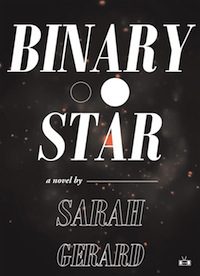
There used to be a ride at my local amusement park called Time Shaft, a rotor ride where you got spun around with increasing speed, the centrifugal force pushing you against the wall as the floor dropped out beneath you. Reading Binary Star brought back some of that feeling of being spun into suspension. It feels dangerous and ecstatic; it feels sick.
Most literary narratives of female anorexia and bulimia are housed in either the young adult problem novel or the eating disorder memoir. With the exception of Chris Kraus’s Aliens and Anorexia, a hybrid text that describes Kraus’s anorexia as one strand of a complex narrative that also involves a long-distance BDSM relationship and the making of a film, most are mired in the psychiatric discourse on eating disorders, which locates the root of the disorder in individual psychopathology and/or family dysfunction, as opposed to culture and/or social/political depression.
Binary Star presents us with a female character who adheres to severe food restrictions as a form of affinity with the nonhuman—both animal and celestial. Her anorexia is partly informed (and enabled) by a commitment to veganarchism and involvement with animal liberation; her investments seem rooted in not just ethics but also identification: “I read books on animal liberation. I feel they are about me.” A graduate student in astronomy, she also identifies strongly with stars, and understands her body management practices in these terms:
I have made myself empty of intention. My body is hollow: a form. A vessel.
An exploding vessel.
Gas.
This celestial metaphor extends to her relationship: together with her long-distance boyfriend John, she forms part of a binary star system, two stars orbiting a common center of mass. She and John collaborate in a relationship organized around supporting their separate pathologies: her anorexia/bulimia, his alcoholism. Much of the narrative chronicles a road trip. They’ve struck a deal: she can’t purge; he can’t drink. They both do it anyway. It becomes clear that this relationship is co-dependent, cannibalistic. “Picture one star eating another,” the narrator instructs her astronomy students. “Picture them both devastated.”

Although it hits on multiple interesting levels, the celestial metaphor becomes somewhat wearisome in the second half of the novel, mostly because explanations of star processes keep coming after the metaphor is already well-established. Despite being overdone in parts, Gerard’s metaphor remains dynamic, largely because the novel’s title describes its form as well as its characters. Much of the narrative is written in bursts of dialogue without tags, the two voices swirling around and merging into each other. It’s frequently difficult to discern who is speaking, or whether language communicates dialogue or narration. This is especially true of the sequence of numberless pages that opens the novel. Here the language seems to float, as if in space, performing a disembodied orbiting, a spiraling in that is cause for alarm: “I help John become me. It is the cruelest thing I do.”
Even as the two main characters circle each other continuously, and cover lots of ground spatially, the novel presents little affective movement, sustaining a feeling of flat resignation throughout. Gerard’s prose is brittle, thin, economical, arguably an example of what Kate Zambreno has called an anorexic mode of writing. (Binary Star shares certain qualities with Zambreno’s own tightly constructed Green Girl.) Most sentences are short and declarative; many are fragments. Like their narrator, these sentences seem conscious of the weight they accrue as they gather. A heaviness pools around them, a chronic melancholia. “I don’t have a sense of humor,” the narrator insists early on. Maybe so. At times the flatness reads as interestingly deadpan. This narrator does not seek to enchant the reader. She is estranged from humanity and would prefer not to be human, or matter, at all: “I hate that I’m material,” she states flatly. Elsewhere, she declares, “I want nothing. Nothing. I actually want Nothing.”
Counterbalancing its heaviness, the prose also achieves a certain ecstasy of lightness, of breathless possibility. If the narrator herself is stagnant, it’s the stagnancy of spinning eternally on an established orbit. Binary Star suspends us in this state, and our stomachs lurch only when the ride stops. “Revolution is a spiral,” the narrator asserts. In its spiraling, the novel asserts a politics of radical negativity that culminates not in recovery from pathology, as most eating disorder narratives do, but in political action. Whether her action has revolutionary (or therapeutic) potential seems irrelevant: she has at last broken free from her orbit.




